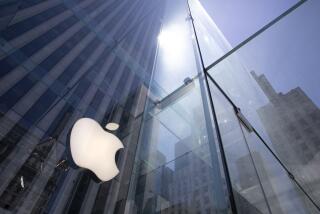Apple’s updated MacBook Air props up cloud computing
Reporting from San Jose — Earlier this summer, Apple eliminated its entry-level plastic-clad MacBook to make the just-updated MacBook Air line, once a pricey niche laptop, its mainstream computer.
In making the move, Apple signaled its view that the future of laptops would be lightweight machines that increasingly rely on cloud services provided through remote servers. It comes as the company gears up to push its iCloud service and vision of a highly synchronized world in which music and other material can be accessed across a number of highly mobile devices.
“It’s about the mobile Internet and cloud computing,” Sterne Agee analyst Shaw Wu said. “It’s just getting started.”
Apple’s strategy envisions a modern world that relies on computers on the go — Internet-connected smartphones, tablets and paper-thin laptops that are light and easy to carry. The just-replaced low-end MacBooks, like the MacBook Pros, are heavier, thicker and have a hard drive that, while enabling users to store more content on their laptops, is bigger and has moving parts. The MacBook Pros have the processing power and storage capabilities to replace desktop computers.
The MacBook Air uses flash memory that limits how much can be stored on the machine. By losing some computing capabilities, the MacBook Air gains longer battery life and lightness, making it the ultimate mobile device in an era in which more content will be stored in the cloud.
“I think [Apple’s] iCloud strategy is very real and this is a further sign of it,” Wu said.
When then-Apple CEO Steve Jobs, who resigned Aug. 24, introduced the company’s new online storage and syncing service in June, he said Apple was ushering in the “post-PC” era of computing in which people would be connected to their digital data no matter where they were or what Apple device they were using. Although cloud services are not new, Apple’s iCloud technology is built into its operating systems — the iOS for the iPhone, iPod touch and iPad, and the Mac OS for its laptop and desktop computers. This, Jobs said, ensures the service is seamlessly tied into the Apple ecosystem.
Jobs, though, did not announce the death of traditional laptops. On the contrary, Apple seems firmly committed to its aluminum unibody laptops.
With the entry-level MacBook Air now offered at $999, Apple is pushing its thin-is-in strategy as the rest of the industry also shifts to lighter laptops. In May, Intel announced the Ultrabook, a less-than-1-inch-thick tablet-like laptop, and said thin devices would be 40% of the consumer laptop market by the end of next year.
Taiwan-based Asus said it would offer an Ultrabook based on Intel’s chips for the holiday season. Sony recently introduced its super-thin Vaio Z.
When Jobs introduced the MacBook Air in 2008, he called it the “world’s thinnest laptop.” Its slender design was tech eye-candy. Priced at $1,800, though, the computer was viewed as fun and sleek but not practical for most consumers. A drop in the cost of components and flash memory has helped make the sleek machines much more affordable.
“Every time they get rid of something and replace it with something new, that becomes the mainstream product,” said Tim Bajarin, president of Creative Strategies. “They are the only company that does that. The norm is, if you have a successful product, you don’t kill it.”
Analysts, though, don’t expect Apple to kill its MacBook Pro line, which includes such features as more powerful processing for doing things such as video editing, optical disc drives that allow users to play DVDs and copy material onto them and a graphic chip that lets users play more intensive games.
“You will see Apple put more emphasis on the MacBook Air,” Bajarin said. “The MacBook Air will become the lion’s share of [sales] of its laptop line. But this does not mean they will do away with the MacBook Pro.”
The new MacBook Air, which comes in 11-inch and 13-inch models, is equipped with Intel’s Sandy Bridge ultra-low-voltage processors, a backlit keyboard and the latest ports, dubbed Thunderbolt, which allow users to transfer much more data than previously. The 11-inch model weighs a bit more than 2 pounds and provides up to five hours of battery life, while the 13-inch Air weighs about 3 pounds and offers up to seven hours of battery life. MacBook Air models range in price from $999 to $1,600 without add-ons.
Although the MacBook Airs aren’t loaded with Intel’s “latest and greatest” fast chips, which suck up battery power more quickly, they get the job done for most consumers, IDC analyst Bob O’Donnell said.
“The bottom line is, notebooks have a future,” he added. “You look at the MacBook Air and see that notebooks have a future.”
Boudreau writes for the San Jose Mercury News/McClatchy.
More to Read
Inside the business of entertainment
The Wide Shot brings you news, analysis and insights on everything from streaming wars to production — and what it all means for the future.
You may occasionally receive promotional content from the Los Angeles Times.










